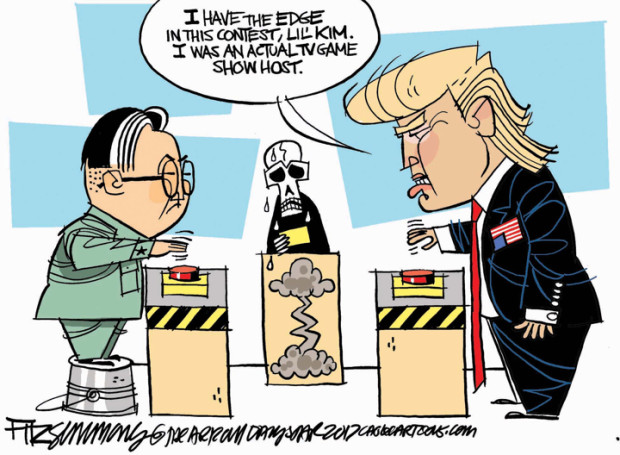
I may be wrong but hasn’t the no nucs in North Korea ship sailed. Obviously Kim Jong-un already has nuclear weapons; he keeps testing them. Obviously, he has medium range and long range missiles. He’s sending them over Japan with some regularity these days. President Trump drew a new redline at North Korean acquisition of an ICBM missile, but that’s just a matter of time. The president’s tactics are now to get down in the mud with the North Korean dictator and lob schoolyard insults at him, a game they’ve both played for the whole of their careers. It’s a bully one upmanship contest that Trump can’t win. He’s not going to out bully a bully who sees the United States as Bully Numero Uno in the world. Kim has done what he’s done to poke the bear, mindful of hardline North Korean generals and his own hero worship at home. He wants to elevate his status on the world stage. Kim’s David is slinging missiles at the US Goliath, a hero in his own mind.
 The latest round of name calling featured 45 withdrawing behind successive red lines, an Obama thing he’d rather die than repeat; except that he has. It’s like the conversational idle threats your mother used. Kim threatened to send a missile to Guam, perhaps too direct a challenge to the US, and settled for launching a rocket over Japan. Trump countered with more insults and the US imposed its own sanctions. Kim then tested his possible hydrogen bomb. The US then pushed through more sanctions in the UN. And the US flew jets along the Korean coast, just far enough out to sea that they were outside the range of North Korean missiles, as a show of force. The South Koreans are moving to install more anti-missile interception defenses; the Japanese are seriously beefing up their current military forces and talking about rearming in their own defense, perhaps with their own nuclear weapons. Japan swore that it would never possess nuclear weapons and codified it into their Constitution, but they’re rethinking that now.
The latest round of name calling featured 45 withdrawing behind successive red lines, an Obama thing he’d rather die than repeat; except that he has. It’s like the conversational idle threats your mother used. Kim threatened to send a missile to Guam, perhaps too direct a challenge to the US, and settled for launching a rocket over Japan. Trump countered with more insults and the US imposed its own sanctions. Kim then tested his possible hydrogen bomb. The US then pushed through more sanctions in the UN. And the US flew jets along the Korean coast, just far enough out to sea that they were outside the range of North Korean missiles, as a show of force. The South Koreans are moving to install more anti-missile interception defenses; the Japanese are seriously beefing up their current military forces and talking about rearming in their own defense, perhaps with their own nuclear weapons. Japan swore that it would never possess nuclear weapons and codified it into their Constitution, but they’re rethinking that now.
We might ask how the North Koreans got so good so fast. Rumor has it that Kim acquired some Ukrainian missile technology through the black market, perhaps Russian mafia mediated, from a downsized missile factory in Crimea. We also know that the North Koreans have sent legions of students to study areas relevant to engineering and technology in China, likely stealing some designs just as the Chinese are want to do. Now, Kim probably doesn’t need much outside assistance to keep his missile factory humming except for the purchase of jet and rocket fuel components and basic fuels to run industrial production – oil, coal.
Kim seems to have been able to circumvent sanctions, either through Chinese merchants who continue to export goods unmonitored or actively assisted by corrupted Chinese government officials, or through other black market sources. He’s chuckling after every successful missile launch that he accomplished this right under the nose of the United States, who was trying to mobilize the rest of the world to its anti-nuclear cause. The Korean dictator holds up Muammar Qaddafi as the dictator who, after being wooed into relinquishing his nuclear weapons, was targeted, toppled and executed by the United States government. Now that he is so close to establishing North Korea as a nuclear power and therefore, an international player, there are no negotiations or sanctions that will deter him. Only his assassination would stop him dead and even then, a hard line military successor could take up the sword in the absence of the military destruction of the country. There’s no walking that back.
 The BullyPresident has confirmed the North Korean dictator’s worst nightmare. From his UN Assembly speech, “if the United States is forced to defend itself or its allies, we will have no choice but to totally destroy North Korea.” Boom, it could not be any clearer. Kim fired back, calling Trump a “mentally deranged US dotard”, a fitting insult that probably sent Trump or a subordinate scurrying to a dictionary for the definition, although he certainly got the gist. Kim has made it clear that he must respond to what he considered a declaration of war, gearing up his defense and possible preemptive action.
The BullyPresident has confirmed the North Korean dictator’s worst nightmare. From his UN Assembly speech, “if the United States is forced to defend itself or its allies, we will have no choice but to totally destroy North Korea.” Boom, it could not be any clearer. Kim fired back, calling Trump a “mentally deranged US dotard”, a fitting insult that probably sent Trump or a subordinate scurrying to a dictionary for the definition, although he certainly got the gist. Kim has made it clear that he must respond to what he considered a declaration of war, gearing up his defense and possible preemptive action.
Trump’s pronouncements on the Iran Nuclear Agreement are adding poison to the well. If the US is threatening to walk away from a long established international treaty there is not a chance in hell that the Korean dictator would believe any deal with the US is worth the paper it’s’ written on, nor should he.
Trump is steadfastly striking out on a go-it-alone path, or what he thinks is his best deal sealing posture. But it’s tough to make a deal when you’re the only one seating at the table. Trump can’t tweet an invitation to Kim to a fireside chat. The US has no diplomatic relationship with North Korea (ah this might be a good time for Jared to set up a illegal backchannel through perhaps the Chinese Embassy). But international agreements are not the result of two leaders and their interpreters hammering out a few details. They are the result of intensive preparation by state department experts, steeped in the history of regional interests, past relationships and current intelligence, strategizing with diplomatic personnel. Rex Tillerson’s hollowed out State Department has no such personnel. Right now, the generals seem to be in charge of diplomacy as well as war preparation. Military men are generally ill suited for diplomacy. Even if a Trump-Kim Jong-un negotiated settlement were achievable, it is meaningless without some buy-in from other countries in the region, South Korea, China, Japan, all with their own and sometime conflicting interests.
The diplomatic world, stubbornly unlike the business world (thank your deity), greeted the BullyPresident’s belligerent UN Assembly speech with shock and awe. The use of the “Rocket Man” moniker for Kim before the global assembly is reminiscent of past leaders who stooped to undignified name calling for less than honorable positions, but it’s an “American First” for the leader of the free world. So were the twenty-one uses of the word “sovereignty” scattered throughout the text. TheCelebrityPresident is setting another Guinness record here. Many in the UN assembly were watching 45’s limp withdrawal from the international community. But his posturing is inching him further out on a limb. Many nations have looked at Trump’s verbal projectiles launched at the North Korean dictator as instigating a fight that through overzealousness could result in a nuclear war. His remarks are making him look like the bad guy.
During the speech, Trump reassured diplomats from less democratic governments that the US no longer had any interest in supporting human rights or regime change, somewhat incongruous in light of his threats to North Korea. After all, his administration is less than a shining example. He went further to suggest intense interest in Venezuela’s recent move toward dictatorship under Maduro. On the other hand, Crimea, and the Russian assault on the Ukraine mostly escaped mention.
What are potential solutions? First, the world will have to shift to developing a strategy to accomodate another nuclear armed country, even as decades long efforts for denuclearization have sputtered to a halt as the detente between Moscow and the US dissolved. The real object of North Korean wrath is the United States; the country seems to have little interest in territorial expansion, at least for now. Yes, Kim’s ultimate objective is a unified Korea, but that doesn’t appear to be immediate, although once the country has consolidated acknowledgement of its nuclear prowess, it’s hard to predict. But a global response will require a global agreement, perhaps through the UN but also through multinational agreements initiated by the United States. These will require serious diplomatic negotiations, for which the Trump administration is ill prepared and has so far refused to engage. But America First can only fail in this endeavor if it chooses to go it alone rather than marshall the international community.
Among possible tools to thwart further North Korean missile launches and nuclear testing would be cyber espionage of North Korean missile systems and power grids, a new approach now within reasonable bounds against hostile enemies, used against Iran in its nuclear build up. North Korea itself engages in cyber espionage, not that that is a justification. The unfortunate Wikileaks of NASA anti-terrorist cybertools has retarded those efforts, but one can only assume that the agency has been furiously working on re-creating new tools and hopefully securing them more thoroughly than in the past.
For the moment, we wait for Kim Jong-un’s next move. In the past, North Korean provocations have been on isolated individuals, like Auto Waimer or others charged with espionage or symbolically tangential, as with the missiles into the ocean toward Japan. The missiles over Japan have been the boldest yet. The threatened hydrogen bomb test over the Pacific would seem too aggressive for all the nations in the region if not the world, so it is unlikely; another subterranean test though is not. Parenthetically, there is no definitive evidence that a previous detonation was in fact a hydrogen bomb; that was a deduction from seismic calculations which may be subject to simulated deceptions. Let’s keep our fingers crossed that there is now an intense backchannel diplomatic effort to acknowledge North Korea’s nuclear arsenal and with that acknowledgement, deter further missile wagging. From there, it’s a question of offering economic support and restructuring sanctions as conditional benchmarks are met. It’s a pipe dream I know, but that would be the Hollywood happy ending.
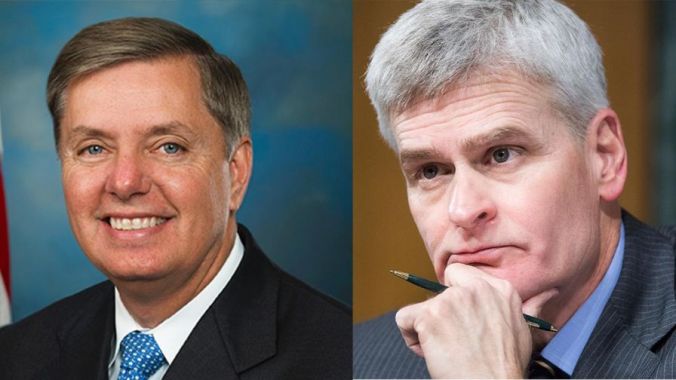 Conservative Republicans haven’t given up on Making America Sick Again. Much like Glenn Close in
Conservative Republicans haven’t given up on Making America Sick Again. Much like Glenn Close in 
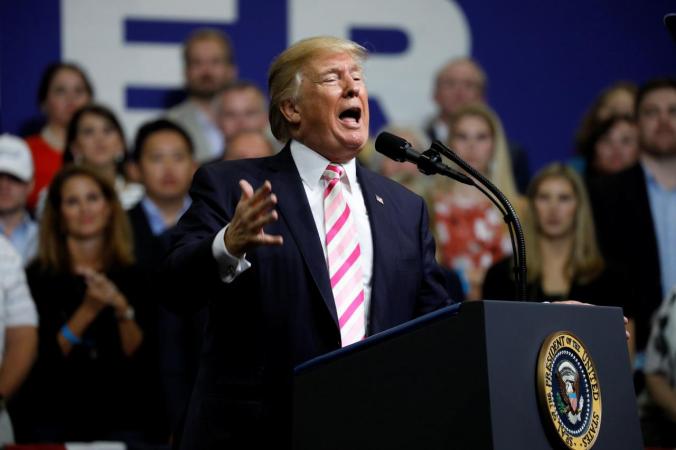 I submit that Trump is being even more disrespectful of the American flag when he defends white supremacists and neo-Nazis as “good guys” after they chant “Jews will not replace us” in a torchlit march in Charlottesville that looked like a 1930s Hitler rally. I submit that Trump is being even more disrespectful of the American flag when he calls for the firing of Black athletes for using their First Amendment right in front of his political rally of white supporters in a bastion of the former Jim Crow South, Alabama. I submit that when the President of the United States calls on a business to fire employees for exercising their First Amendment rights, that is unAmerican. Further, for the President of the United States to dog whistle racist overtones into his political rallies for his second term is also un-American, even in the context of the Make America White Again overt racist threats against all people of color that is so easily being tolerated in the halls of both federal and state governments today.
I submit that Trump is being even more disrespectful of the American flag when he defends white supremacists and neo-Nazis as “good guys” after they chant “Jews will not replace us” in a torchlit march in Charlottesville that looked like a 1930s Hitler rally. I submit that Trump is being even more disrespectful of the American flag when he calls for the firing of Black athletes for using their First Amendment right in front of his political rally of white supporters in a bastion of the former Jim Crow South, Alabama. I submit that when the President of the United States calls on a business to fire employees for exercising their First Amendment rights, that is unAmerican. Further, for the President of the United States to dog whistle racist overtones into his political rallies for his second term is also un-American, even in the context of the Make America White Again overt racist threats against all people of color that is so easily being tolerated in the halls of both federal and state governments today. 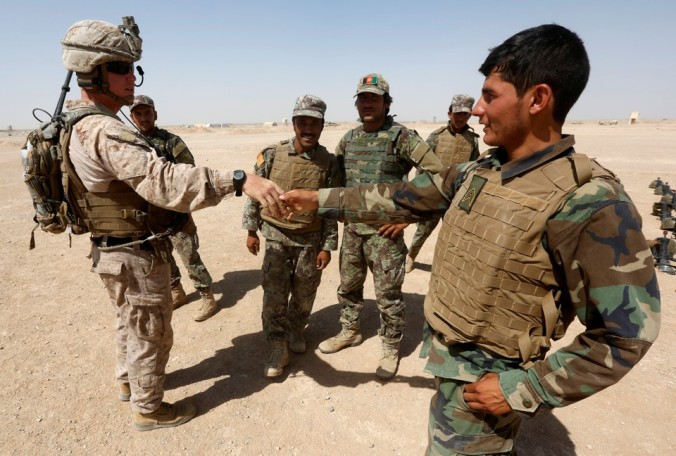 The president’s announcement of his own policy on Afghanistan essentially sounded like a rehash of the old but without a stated objective or strategy or timeline. In fact, he pretty much said he wasn’t going to divulge anything about strategy or troop strength, as that would be aiding and abetting the enemy. And long term goals are not in the CelebrityPresident’s wheelhouse; he’s strictly a president of now. And he loves the surprise ending. One thing we do know is that Trump’s America First is not in the business of nation building. Unfortunately, without that nation building piece, the United States will be stuck in Afghanistan for years and years, unless, of course, a nuclear holocaust has intervened or we give up the ghost and but out like in Vietnam.
The president’s announcement of his own policy on Afghanistan essentially sounded like a rehash of the old but without a stated objective or strategy or timeline. In fact, he pretty much said he wasn’t going to divulge anything about strategy or troop strength, as that would be aiding and abetting the enemy. And long term goals are not in the CelebrityPresident’s wheelhouse; he’s strictly a president of now. And he loves the surprise ending. One thing we do know is that Trump’s America First is not in the business of nation building. Unfortunately, without that nation building piece, the United States will be stuck in Afghanistan for years and years, unless, of course, a nuclear holocaust has intervened or we give up the ghost and but out like in Vietnam. 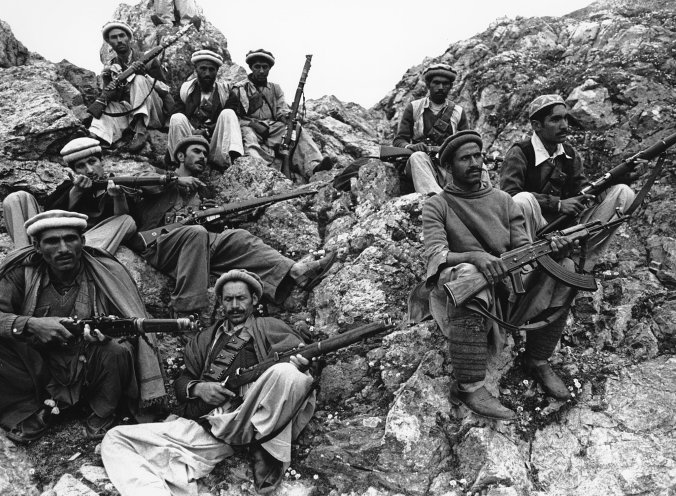 Beginning in 1839, the British Empire fought three wars in the country for over 80 years, finally withdrawing in 1919 by granting Afghanistan independence at the close of WWI. The Soviet Union invaded Afghanistan in 1979 to support the government in a developing civil war during an era where they were extending a policy of stabilizing the neighboring Asian republics of now Kazakhstan, Uzbekistan, Turkmenistan and Tajikistan. Unlike those other countries, the Afghans proved difficult to manage assisted by the United States, Pakistan and Saudi Arabia. The Soviets like the British before them found themselves isolated in the Afghan capital of Kabul and other well fortified positions scattered in a vast sea of hostile countryside, controlled by rebellious warlords. When the Soviet army limped out of the country in 1989, they left the country with more landmines than anywhere else on the planet and a puppet regime that disintegrated into years of civil wars. Those wars set the stage for the rise of the Taliban.
Beginning in 1839, the British Empire fought three wars in the country for over 80 years, finally withdrawing in 1919 by granting Afghanistan independence at the close of WWI. The Soviet Union invaded Afghanistan in 1979 to support the government in a developing civil war during an era where they were extending a policy of stabilizing the neighboring Asian republics of now Kazakhstan, Uzbekistan, Turkmenistan and Tajikistan. Unlike those other countries, the Afghans proved difficult to manage assisted by the United States, Pakistan and Saudi Arabia. The Soviets like the British before them found themselves isolated in the Afghan capital of Kabul and other well fortified positions scattered in a vast sea of hostile countryside, controlled by rebellious warlords. When the Soviet army limped out of the country in 1989, they left the country with more landmines than anywhere else on the planet and a puppet regime that disintegrated into years of civil wars. Those wars set the stage for the rise of the Taliban. The United States began a new war soon after 9/11. In the interim, more than one million American soldiers have served in the country, over 2400 have lost their lives and Afghan civilians are still dying at a rate of over 3000 annually. Now 16 years in, so far this year, there have been 11 American casualties. After a peak military presence of 100,000 soldiers, a force of about 12,000 American “military advisors and trainers” support about 300,000 Afghan security forces, stationed in isolated bases, much like the British and Soviets had been. Many suspect that the number of Afghan troops is overestimated by as much as 40%, similar to the “ghost soldier” in Iraq, a name on the military rolls unassociated with a body that is drawing a salary.
The United States began a new war soon after 9/11. In the interim, more than one million American soldiers have served in the country, over 2400 have lost their lives and Afghan civilians are still dying at a rate of over 3000 annually. Now 16 years in, so far this year, there have been 11 American casualties. After a peak military presence of 100,000 soldiers, a force of about 12,000 American “military advisors and trainers” support about 300,000 Afghan security forces, stationed in isolated bases, much like the British and Soviets had been. Many suspect that the number of Afghan troops is overestimated by as much as 40%, similar to the “ghost soldier” in Iraq, a name on the military rolls unassociated with a body that is drawing a salary.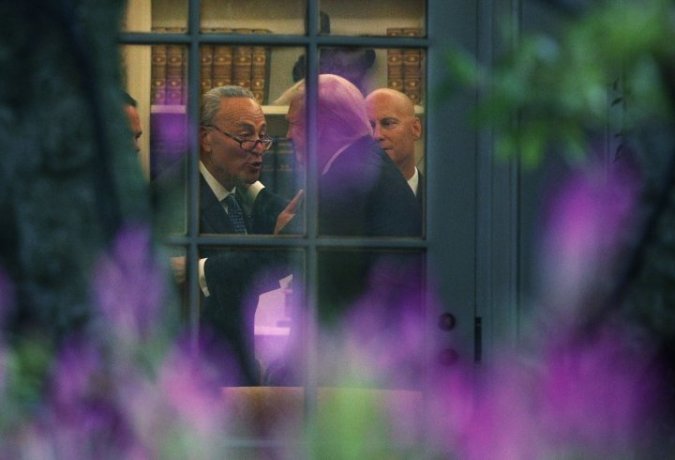 The Dealmaker in Chief is riding high now. We hear there was a new bounce in his step. He finally made a deal, seven months into his presidency. He skirted the GOP leadership in Congress, basically ambushing them in an Oval office meeting with Democratic leaders Chuck Schumer and Nancy Pelosi. With Mike Pence grinning at his side, he jumped into bed with the Democrats and threw the GOP leadership under the bus. It seemed like a snap decision made mid-meeting. Some have hinted that 45 just got bored, given his limp attention span. Apparently what clinched it for the Donald was that the Democrats had the votes for their proposal, a sure thing, while the Republicans were still fumbling with theirs, an outcome yet to be determined, with Democrats aligned against it and some Tea Partyers unenthusiastic.
The Dealmaker in Chief is riding high now. We hear there was a new bounce in his step. He finally made a deal, seven months into his presidency. He skirted the GOP leadership in Congress, basically ambushing them in an Oval office meeting with Democratic leaders Chuck Schumer and Nancy Pelosi. With Mike Pence grinning at his side, he jumped into bed with the Democrats and threw the GOP leadership under the bus. It seemed like a snap decision made mid-meeting. Some have hinted that 45 just got bored, given his limp attention span. Apparently what clinched it for the Donald was that the Democrats had the votes for their proposal, a sure thing, while the Republicans were still fumbling with theirs, an outcome yet to be determined, with Democrats aligned against it and some Tea Partyers unenthusiastic.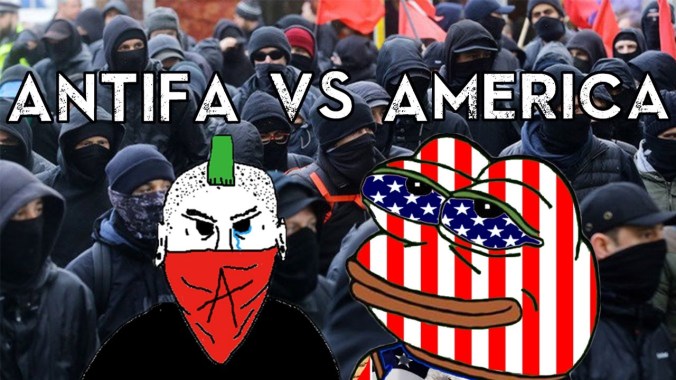
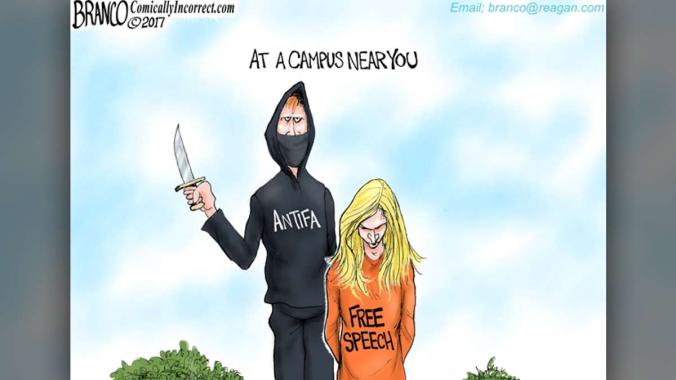 But this approach is problematic on multiple levels. They continuously trample on the right to free speech and free assembly. They think they are protecting people from harm while simultaneously offensively inflicting injury on others. They have designated themselves as the judge and the jury; theirs is the lens through which speech is permitted. It is their judgement that decides whose views should be heard or crushed. I, for one, want to use my own judgement and resent their interference in my decision making.
But this approach is problematic on multiple levels. They continuously trample on the right to free speech and free assembly. They think they are protecting people from harm while simultaneously offensively inflicting injury on others. They have designated themselves as the judge and the jury; theirs is the lens through which speech is permitted. It is their judgement that decides whose views should be heard or crushed. I, for one, want to use my own judgement and resent their interference in my decision making.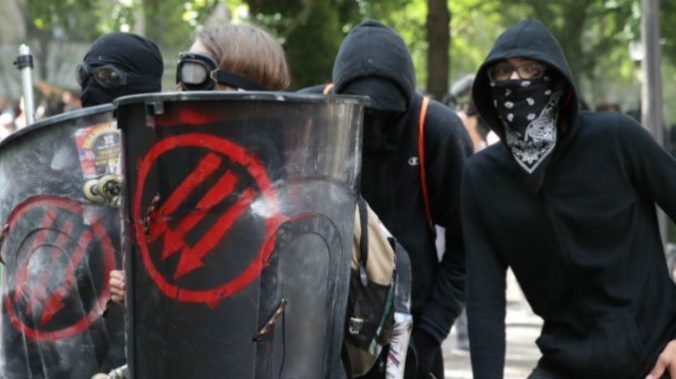 Trumpophants in turn see antifa actions as assaults, attacks on freedom of assembly to which they respond with violence to reassert their rights. This is brewing street wars, not seen since the 1960s. When a white supremacist called a march in Sacramento to protest the attacks at Trump rallies, Anti-Fascist Action Sacramento counter protest resulted in 10 people being stabbed. In demonstrations against the Yiannopoulos appearance at Berkeley, where masked antifa threw Molotov cocktails and rocks at police, a white nationalist named Kyle Chapman retaliated by hitting an antifa activist over the head with a wooden post. Crowdfunding by the far right generated $80,000 for Chapman’s legal defense.
Trumpophants in turn see antifa actions as assaults, attacks on freedom of assembly to which they respond with violence to reassert their rights. This is brewing street wars, not seen since the 1960s. When a white supremacist called a march in Sacramento to protest the attacks at Trump rallies, Anti-Fascist Action Sacramento counter protest resulted in 10 people being stabbed. In demonstrations against the Yiannopoulos appearance at Berkeley, where masked antifa threw Molotov cocktails and rocks at police, a white nationalist named Kyle Chapman retaliated by hitting an antifa activist over the head with a wooden post. Crowdfunding by the far right generated $80,000 for Chapman’s legal defense. 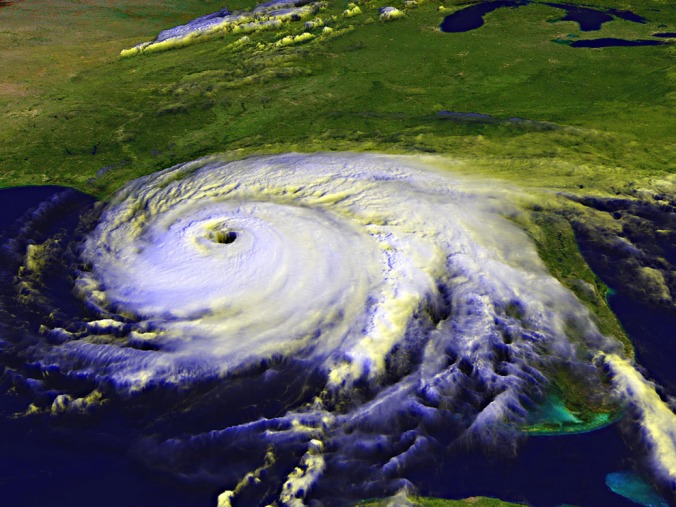 As all eyes and the media were laser focused on the struggle of storm victims to survive Hurricane Harvey, 45 was probably feeling ignored. Harvey was sucking up all the media air; his tweets were being downplayed or ignored. Harvey’s ratings were higher than his, unprecedented! The North Koreans launched more missiles, and he fell to third place. The storm challenged the president to calm the country’s fears; to applaud the people leading the response and commiserate with those whose lives were disappearing in the deluge. The CelebrityPresident never fails to disappoint. True to being Trump, he tripped over his ego again.
As all eyes and the media were laser focused on the struggle of storm victims to survive Hurricane Harvey, 45 was probably feeling ignored. Harvey was sucking up all the media air; his tweets were being downplayed or ignored. Harvey’s ratings were higher than his, unprecedented! The North Koreans launched more missiles, and he fell to third place. The storm challenged the president to calm the country’s fears; to applaud the people leading the response and commiserate with those whose lives were disappearing in the deluge. The CelebrityPresident never fails to disappoint. True to being Trump, he tripped over his ego again.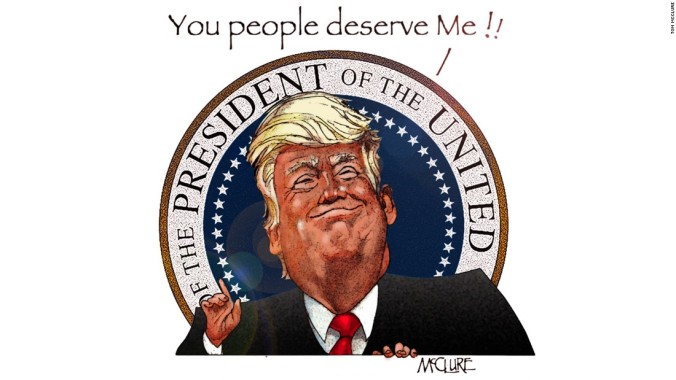 The Donald studiously avoided any contact, even a few words, with victims. He didn’t have to be physically in the rescue centers; Skype or Facetime are great at putting people in different locations together. They could have generated a powerful video clip for the world. Instead he created a mini rally, maybe it was a spontaneously gathered crowd or maybe they had help, and he once again used the platform to brag about his greatness.” What a crowd, what a turnout.” Any place, any time, it’s all about him. Another sight for the history books; a disaster visit turned into a political rally. As he was promising the best recovery ever, he had previously moved to cut funding for FEMA and federal responses to emergencies in the upcoming budget. Just a few days earlier, he had signed an executive order to eliminate Obama rules that infrastructure projects account for predicted changes in
The Donald studiously avoided any contact, even a few words, with victims. He didn’t have to be physically in the rescue centers; Skype or Facetime are great at putting people in different locations together. They could have generated a powerful video clip for the world. Instead he created a mini rally, maybe it was a spontaneously gathered crowd or maybe they had help, and he once again used the platform to brag about his greatness.” What a crowd, what a turnout.” Any place, any time, it’s all about him. Another sight for the history books; a disaster visit turned into a political rally. As he was promising the best recovery ever, he had previously moved to cut funding for FEMA and federal responses to emergencies in the upcoming budget. Just a few days earlier, he had signed an executive order to eliminate Obama rules that infrastructure projects account for predicted changes in